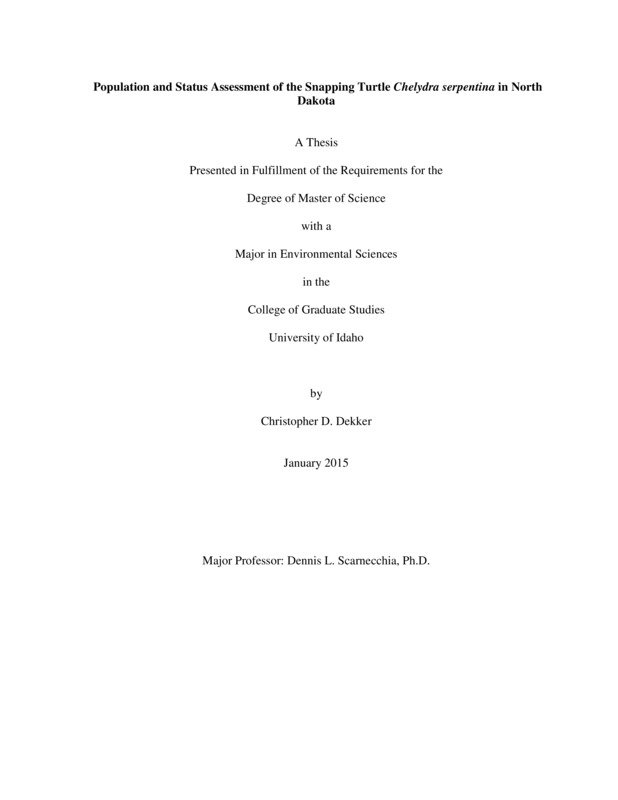Population and Status Assessment of Snapping Turtles Chelydra serpentina in North Dakota
Dekker, Christopher. (2015). Population and Status Assessment of Snapping Turtles Chelydra serpentina in North Dakota. Theses and Dissertations Collection, University of Idaho Library Digital Collections. https://www.lib.uidaho.edu/digital/etd/items/dekker_idaho_0089n_10514.html
- Title:
- Population and Status Assessment of Snapping Turtles Chelydra serpentina in North Dakota
- Author:
- Dekker, Christopher
- Date:
- 2015
- Keywords:
- North Dakota Snapping turtle Snapping turtle age Snapping turtle nesting Snapping turtle overwintering
- Program:
- Environmental Science
- Subject Category:
- Wildlife management
- Abstract:
-
Research was conducted on snapping turtles in North Dakota for two field seasons (2012-2013) to (1) estimate length weight relationships, age structure (based on fourth vertebral scute), growth and population size in three reservoir systems (Lake LaMoure, Nelson Lake, and Patterson Lake), (2) determine overwintering locations, and nesting areas; (3) determine and characterize statewide distribution at the county level; and (4) estimate snapping turtle harvest by fishing license holders in North Dakota. Capturing snapping turtles presented a challenge; overall snapping turtle density was almost three times lower than for the commonly sampled painted turtle. Over the field seasons only 62 individuals were captured. For all turtles (all locations), the weight-converted VBGF was W_t=26745.4[1-e^(-0.0707(t+2.6531) ) ]^3; an individual in weight 7.1kg would be 11 years old. The population estimate for Lake LaMoure, the lake where the highest number of turtles was found, was 48. Eleven of 15 radio-tagged turtles in Lamoure were found during the winter sampling (13-20 January, 2013); all eleven turtles were located in close proximity to each other; the longest distance between any of the tagged turtles was 45 meters. At LaMoure of the turtles were located in the same area they were trapped the year before. Most females made a migration upstream from the bay at some point (Figures 25-29). Some migrations were short and only lasted a day or two; others lasted several days. The location of sightings for radio-tagged males did not vary as much as the females. Males typically stayed within the area they were captured the year before and did not show any signs of migrating. Most of the time the turtles were located in the same bay they were captured in, they moved out of that bay for a short period of time (less than five days) and then returned. In all, 733 people responded to the mail survey with 13 respondents stating they had harvested snapping turtles (55 in all). Several management recommendations are made moving forward to help preserve the existing turtle populations, including the need to (1) develop a Management Plan for snapping turtles in North Dakota, (2) Incorporate turtle recording into standard statewide fish surveys, (3) Reduce fisheries netting mortality of snapping turtles, (4) Develop sound, scientifically defensible harvest management regulations and reporting
- Description:
- masters, M.S., Environmental Science -- University of Idaho - College of Graduate Studies, 2015
- Major Professor:
- Scarnecchia, Dennis L
- Committee:
- Dennis, Brian; Harmon, Luke; Wilson, Patrick
- Defense Date:
- 2015
- Identifier:
- Dekker_idaho_0089N_10514
- Type:
- Text
- Format Original:
- Format:
- application/pdf
- Rights:
- In Copyright - Educational Use Permitted. For more information, please contact University of Idaho Library Special Collections and Archives Department at libspec@uidaho.edu.
- Standardized Rights:
- http://rightsstatements.org/vocab/InC-EDU/1.0/

